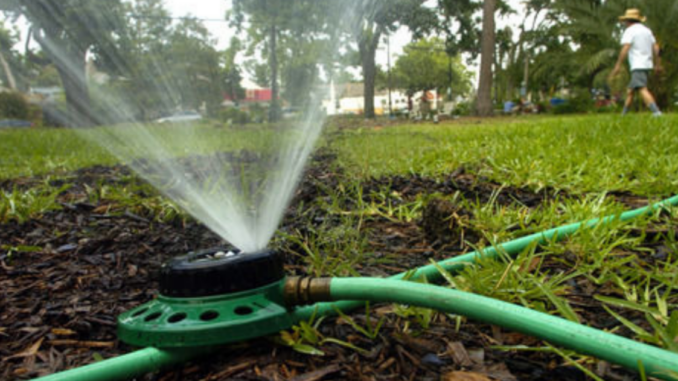
People plant large numbers of trees, shrubs, ground covers, flowers and vegetables in the spring, and new sod is laid during summer. The need to regularly and properly water is especially critical for these new plantings and any plants you have growing in containers. New plantings and container plants are particularly dependent on the gardener for water when the weather is dry, especially as we move into the heat of summer.
Proper watering can make the difference between life and death for new plantings because their roots have not had time to grow out into the surrounding soil, and so they lack well-established root systems. With their root systems still limited to a relatively small area of soil, they are especially vulnerable to drought stress.
Keep in mind that watering too much can be just as bad or worse than watering too little. Plants can recover if allowed to wilt slightly. But keeping them too wet can lead to root rot, which is often fatal.
A volunteer waters a newly planted tree.
About trees
The first summer after planting is the most critical time for newly planted trees, and proper watering plays a major role in whether or how well they survive. Here are some effective watering techniques to get your newly planted trees through hot, dry periods.
The first method is to turn a hose on trickle, lay the end within six inches of the trunk, and let the water trickle for about 20 to 30 minutes.
My favorite method is using a heated metal skewer or ice pick to pierce about 10 holes through the bottom of a 5-gallon paint bucket or similar container (I use old kitty litter containers). Make all the holes to one side. Place the bucket next to the tree trunk with the holes closest to the trunk. Fill up the container, and the water will slowly seep through the holes, providing excellent deep irrigation. You can spray paint the outside of the bucket dark green to make it less noticeable.
Or, you can do something very similar with a commercial product called Treegator® (available online). This is a bag that wraps around the tree’s trunk and, when filled with water, allows the water to slowly seep into the root zone.
Use any of these techniques during hot weather whenever seven to 10 days pass without substantial rainfall. Continue to water twice a week until a good rain occurs. Drought-stressed trees may experience wilting, leaf drop, yellow or brown leaves, scorched leaf edges or even death.

A watering bag provides even hydration for tree.
Shrubs and ground covers
Newly planted shrubs and ground covers will need to be monitored more carefully and watered more frequently than those planted years ago. Water with soaker hoses or sprinklers left on long enough for the water to penetrate at least four to six inches into the soil.
Keep in mind that the roots of newly planted shrubs and ground covers are in a small area about the size of the pot they were growing in before planting. This is especially true for those planted after March, since they have had little time to grow roots into the surrounding soil. Watch new plantings carefully for the same drought symptoms described for trees.
Do not water too frequently or too heavily – root rot may occur if plants are kept too moist. Use the same watering schedule as recommended for trees.
Lawns
Now is a great time to lay sod to install a new lawn or repair an established lawn. Newly laid sod needs special attention. Water it for about 15 to 20 minutes every day for the first seven to 10 days. Then, water for about 30 minutes every other day for another seven to 10 days.
After that, irrigate the lawn thoroughly once or twice a week, as needed, to encourage the roots to grow deep into the soil. Do not water every day for more than 10 days or you may encourage fungus diseases. There is no need to water if adequate rainfall occurs.
Transplants
Until the roots of newly planted vegetable and bedding plant transplants grow out into the surrounding soil, they are very vulnerable to drought stress. If the weather is dry, check the soil in the bed every couple of days.
When it becomes dry, water deeply and thoroughly. You shouldn’t need to water more than two or three times a week. Do not water too frequently and keep the soil constantly wet, as this can lead to root rot.
Containers
Watering plants in containers outside is a constant job during the summer. It is typical to water every day, even twice a day, when the weather is hot and dry.
How often you have to water is influenced by temperature, pot size, the type of potting mix, the drought tolerance of a plant, whether a plant is in sun or shade and how pot-bound a plant is.
Plants need to be watered more frequently when it is hot, if the containers are small, if a light potting mix is used, when plants are in a sunny location and when plants are pot bound.
Clay pots tend to dry out faster than plastic or glazed ceramic pots.
To reduce container watering consider the following: use larger rather than smaller pots, choose a potting mix that retains more water (it must still be fast draining), repot pot bound plants into larger containers, use plastic pots and, if practical, move the plants into somewhat shadier conditions.
The starting lineup for summer: Dan Gill recommends 9 flowers that can take the heat

Leave a Reply